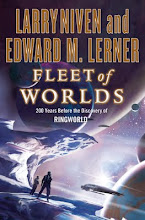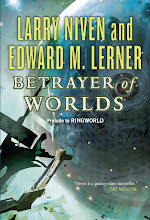As a technologist and an SF author, I am -- no surprise -- enthusiastic about space exploration. So although American astronauts remain dependent on ever-pricier Russian transportation to the ISS, and will remain dependent for several more years, it's good to see that "
These 5 far-out space projects are making science fiction a reality: From 3D food printing to warp drive." (The three projects not named in the subtitle, just to afford you a sneak peek, are: growing plants on the Moon, private mining of asteroids perhaps beginning as early as 2016, and
Tokyo-based Shimizu Corporation wanting to build a giant solar-power plant across the lunar surface.)
 |
| Down a wormhole |
(Many SF authors have toyed with FTL travel [sometimes aka warp drive], asteroid mining, and food synthesizers, so I claim no ground-breaking credit for my own fictional dabbling in those areas. I will, however, point out that paving the Moon with solar cells was a key plot element of my 2005 novel Moonstruck.)
Among the major challenges of exploring other worlds is landing on them. (As a side note, Mars is a particularly tough destination: it offers enough atmosphere to generate reentry heat, but not enough to slow a spacecraft down very much. For more on these and other landing considerations, see, on howstuffworks.com, "How will landing on Mars work?") You wouldn't want to drop a person in the following way, sans airbags and parachutes, but to deliver robotic probes, this is very clever: see "NASA’s Super Ball Bots Set to Explore Saturn’s Largest Moon?"
 |
| Fireball over Chelyabinsk |
Remember last year's asteroid air-burst explosion over Chelyabinsk, injuring thousands? One prospectively positive outcome (that I should have mentioned months ago): "
U.N. to create asteroid defense group." When -- because it's only a matter of time -- a dangerously sized NEO (near Earth object) is spotted in an Earth-threatening orbit, it may be late in the game to start thinking about who should do what and how. Hopefully not too late ...
Three months after the asteroid-defense vote in the General Assembly, and approaching one year since the Chelyabinsk incident, AFAIK the UN's good intentions have yet to progress in any concrete way toward action. (Inaction at the UN ... go figure.)
 |
| Gaia gets ready |
ESA's Gaia probe launched since the posting of the piece I'm about to cite, but this recent article remains one of the better descriptions I've seen for the Gaia mission. See, from
IEEE Spectrum, "
Gaia, ESA's 'Phenomenal' Milky Way Mapper, Is Set to Launch."
The €700 million mission is designed to pin down the three-dimensional
positions and velocities of a billion Milky Way stars, which amounts to
roughly one out of every 100 stars in the galaxy.
 |
| Hubble "deep field" survey |
Many inferences about the cosmos depend on knowing the positions of very distant objects -- astrometry -- and we have decent estimates for very few. The Gaia mission will improve matters a
lot. And while parallax measurements made from Gaia data will apply directly to only (a subset of) stars within our own galaxy, improved estimates of neighborhood distances will serve to improve the calibration of the "
standard candles" used to estimate the distance to other/remote galaxies. Whatever we (think we) understand about cosmological origins, the expansion of the universe, and dark energy derives from what we (think we) know about the latter class of distances.
Are you holding your head? If so, it's with good reason! This next article
isn't astronomical, but check out anyway, from
Science News, "
Thinking hard weighs heavy on the brain."

































No comments:
Post a Comment